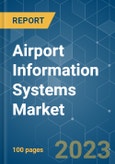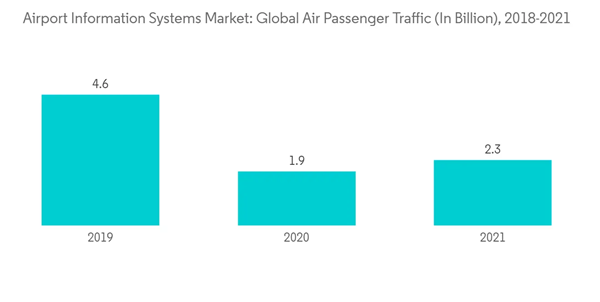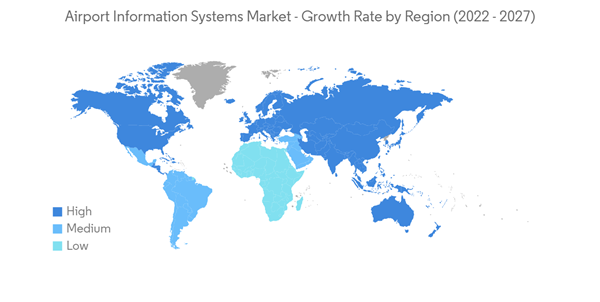The airport information systems market is anticipated to register a CAGR of over 3% during the forecast period.
The COVID-19 pandemic severely impacted global passenger traffic in 2020 and 2021. The aviation industry started improving during 2022 and gradually returned to its pre-COVID-19 level. According to the latest updates from IATA, ICAO, the Airports Council International (ACI), the UN World Tourism Organization (UNWTO), the World Trade Organization (WTO), and the International Monetary Fund (IMF), the international air passenger traffic in 2022 has improved compared to that of 2021. The international air passenger traffic in June 2022 increased by 229.5% compared to June 2021, and the revenue passenger kilometers (RPK) in June 2022 reached 65% of the level in June 2019.
The number of people opting for air travel has increased in the past few years, which has resulted in increased pressure on airports and airlines to opt for advanced systems that can enhance their ground operations and support their goal of reducing aircraft turnaround time. Moreover, to improve efficiency and connectivity, upcoming airports use a variety of technologies, including integrated sensors for temperature and lighting monitoring, smart baggage tags for tracking and directing luggage to the aircraft, biometric check-ins with facial recognition, and cargo warehousing management. Airports are using technologies such as artificial intelligence (AI) and predictive analysis for a wide range of applications, from customer service to operational efficiency. Thus, the integration of such technologies to create an outlook of the operations of an airport and measure performance with associated key performance indicators (KPIs) is anticipated to drive the airport information systems market.
Airports are moving toward centralized architecture to meet the need for information sharing among different parties efficiently. Scanners and monitors are connected to airport systems, and hackers can easily gain access to internal systems through these physical assets. Data from the airport is collected, stored, and distributed daily, based on requirements that are vital for the airport to operate effectively. With regulations and systems becoming more complex, it is a huge task for manufacturers to keep up with appropriate security measures. However, there is a prominent threat of cyberattacks on airports that can lead to widespread disruptions of services. According to a study by the European Aviation Security Agency (EASA), there are an average of 1,000 airport cyberattacks per month. The exploitation of such security vulnerabilities may limit the scope of the integration of airport information systems during the forecast period.
The Asia-Pacific region has the largest number of airport construction projects of all kinds (runways, terminals, etc.) known to be underway, with more than 220 projects in the region alone. Also, the region also has more than 110 greenfield projects in the planning stage, the highest in the world. Two major markets in the region, China and India, are driving the growth of airport investments.
China plans to construct 216 new airports by 2035, and the Indian government plans to develop 100 additional airports by 2024. This signifies a huge opportunity for airport information system integrators, as the adoption of smart airport concepts would foster the demand for sophisticated airport information systems during the forecast period. In July 2022, India’s flagship airline, Air India has selected Amadeus Altea Passenger Service System Suite (PSS) as part of the carrier’s revitalization, for its customers interfaces. The implementation includes revenue management, revenue accounting, retailing and merchandising, website.
In February 2022, SITA Airport Management Systems streamlined the operations at London Luton Airport (LLA) by automating routine tasks. These streamlined operations increased productivity and operational efficiency and led to time and cost savings for London Luton and multiple other airports that implemented this system. The successful implementation of such projects is expected to help the companies gain more customers in the years to come.
This product will be delivered within 2 business days.
The COVID-19 pandemic severely impacted global passenger traffic in 2020 and 2021. The aviation industry started improving during 2022 and gradually returned to its pre-COVID-19 level. According to the latest updates from IATA, ICAO, the Airports Council International (ACI), the UN World Tourism Organization (UNWTO), the World Trade Organization (WTO), and the International Monetary Fund (IMF), the international air passenger traffic in 2022 has improved compared to that of 2021. The international air passenger traffic in June 2022 increased by 229.5% compared to June 2021, and the revenue passenger kilometers (RPK) in June 2022 reached 65% of the level in June 2019.
The number of people opting for air travel has increased in the past few years, which has resulted in increased pressure on airports and airlines to opt for advanced systems that can enhance their ground operations and support their goal of reducing aircraft turnaround time. Moreover, to improve efficiency and connectivity, upcoming airports use a variety of technologies, including integrated sensors for temperature and lighting monitoring, smart baggage tags for tracking and directing luggage to the aircraft, biometric check-ins with facial recognition, and cargo warehousing management. Airports are using technologies such as artificial intelligence (AI) and predictive analysis for a wide range of applications, from customer service to operational efficiency. Thus, the integration of such technologies to create an outlook of the operations of an airport and measure performance with associated key performance indicators (KPIs) is anticipated to drive the airport information systems market.
Airports are moving toward centralized architecture to meet the need for information sharing among different parties efficiently. Scanners and monitors are connected to airport systems, and hackers can easily gain access to internal systems through these physical assets. Data from the airport is collected, stored, and distributed daily, based on requirements that are vital for the airport to operate effectively. With regulations and systems becoming more complex, it is a huge task for manufacturers to keep up with appropriate security measures. However, there is a prominent threat of cyberattacks on airports that can lead to widespread disruptions of services. According to a study by the European Aviation Security Agency (EASA), there are an average of 1,000 airport cyberattacks per month. The exploitation of such security vulnerabilities may limit the scope of the integration of airport information systems during the forecast period.
Airport Information Systems Market Trends
Growing Investments Toward Upgrading Airport Terminals
The pandemic had a significant impact on global passenger traffic; however, the number of scheduled passengers handled by the global airline industry had increased in the last decade. This has been the primary driving force for the airports to invest in new and advanced airport information systems. With the focus on enhancing the passenger experience, several airports across the world have invested in developing various new information and airport management technologies to aid the travel experience for passengers. Airports are also developing agile systems to predict capacity demand, provide an enhanced passenger travel experience, improve operational process efficiency, improve staff productivity, and ensure safety and security. New technologies and various passenger check-in methods are being implemented across various airports around the world to increase the ease of usage and air travel for new passengers. For instance, in October 2022, Perth Airport installed new self-service kiosks and bag drop units and announced that it would start trialing biometric passenger processing, with a Singapore Airlines flight being the first to start the process. Expansion of existing airports also increases the market. For instance, in October, construction of a new terminal at Gwalior airport in Madhya Pradesh, India, began. The new terminal is being built on 20,000 square meters, with an investment of INR 450 crores.Asia-Pacific to Witness the Highest Growth During the Forecast Period
Asia-Pacific, with a huge pool of passengers utilizing air travel services, occupies the largest has some of the largest airports in the world, catering to the global aviation and air transport industry. Owing to this, the investments in developing, upgrading, and maintaining these airports are increasing. Though the pandemic has slowed down the growth rate of the aviation sector in the region, certain sophisticated systems are being added to the existing aviation infrastructure to promote the seamless movement of passenger traffic. Nevertheless, the expansion or modernization of several airports in the region is currently underway.The Asia-Pacific region has the largest number of airport construction projects of all kinds (runways, terminals, etc.) known to be underway, with more than 220 projects in the region alone. Also, the region also has more than 110 greenfield projects in the planning stage, the highest in the world. Two major markets in the region, China and India, are driving the growth of airport investments.
China plans to construct 216 new airports by 2035, and the Indian government plans to develop 100 additional airports by 2024. This signifies a huge opportunity for airport information system integrators, as the adoption of smart airport concepts would foster the demand for sophisticated airport information systems during the forecast period. In July 2022, India’s flagship airline, Air India has selected Amadeus Altea Passenger Service System Suite (PSS) as part of the carrier’s revitalization, for its customers interfaces. The implementation includes revenue management, revenue accounting, retailing and merchandising, website.
Airport Information Systems Market Competitor Analysis
The airport information systems market is moderately consolidated. Honeywell International Inc., Amadeus IT Group SA, SITA, Raytheon Technologies Corporation, and Thales SA are some prominent players in the airport information systems market. To effectively cater to the evolving capacity demand of the airports, software providers are partnering with hardware manufacturers to develop advanced all-in-one solutions for the end-users at a competitive price point. With increasing emphasis on smart technologies and high investments in digital technological capabilities, the push toward efficiency of airport procedures is expected to increase the usage of information systems implemented in various operational segments of the airport. Multiple new contracts have been awarded by various airports to streamline airport operations. For instance,In February 2022, SITA Airport Management Systems streamlined the operations at London Luton Airport (LLA) by automating routine tasks. These streamlined operations increased productivity and operational efficiency and led to time and cost savings for London Luton and multiple other airports that implemented this system. The successful implementation of such projects is expected to help the companies gain more customers in the years to come.
Additional benefits of purchasing the report:
- The market estimate (ME) sheet in Excel format
- 3 months of analyst support
This product will be delivered within 2 business days.
Table of Contents
1 INTRODUCTION
4 MARKET DYNAMICS
5 MARKET SEGMENTATION (Market Size by Value - USD billion)
6 COMPETITIVE LANDSCAPE
Companies Mentioned (Partial List)
A selection of companies mentioned in this report includes, but is not limited to:
- Airport Information Systems Limited
- Honeywell International Inc.
- Amadeus IT Group SA
- SITA
- Thales Group
- Raytheon Technologies Corporation
- Indra Sistemas SA
- IBM Corporation
- Samsung
- NEC Corporation
- T-Systems (Deutsche Telekom AG)
- Siemens AG
Methodology

LOADING...










